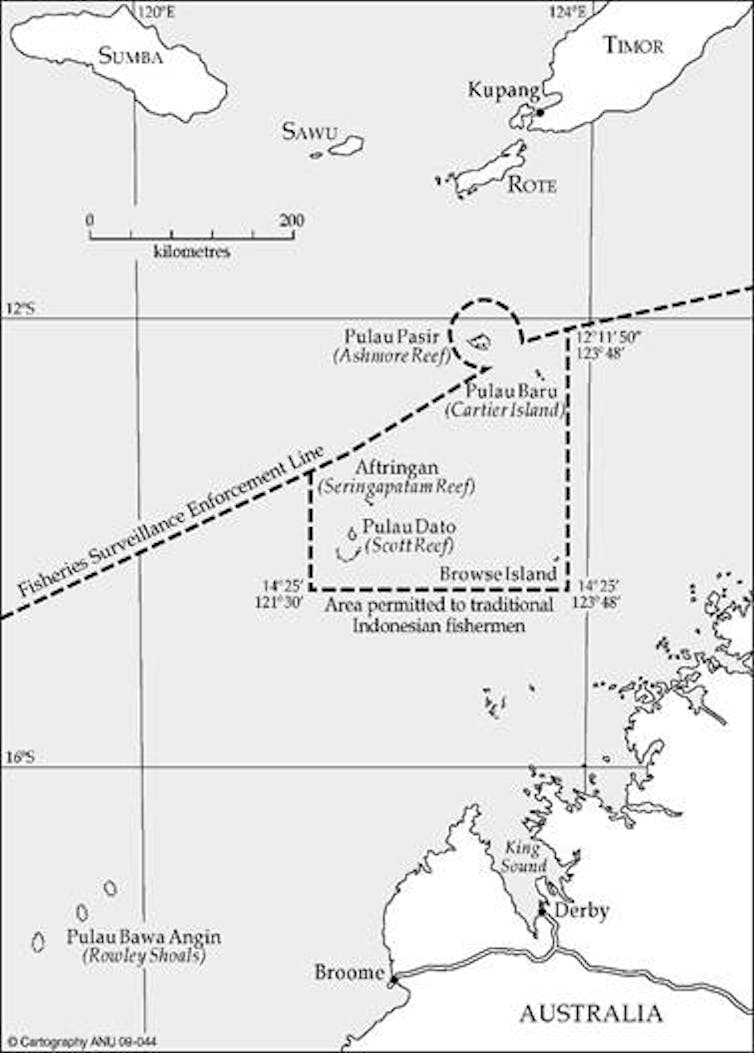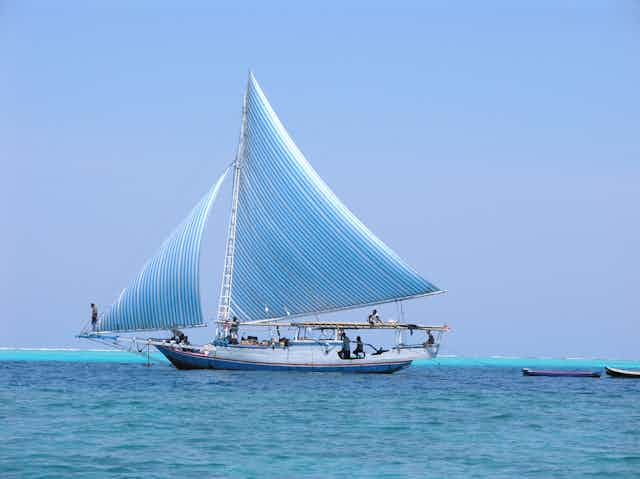This has not been a good year for Indonesia’s fishermen, whose ancestors have been sailing for centuries in Australian waters. COVID-19 has taken its toll. Fish prices have declined, and a disease known as ais-ais has recurred in the seaweed that coastal communities cultivate to supplement their income.
As a result, fishermen told us they have little choice but to continue to sail south. Indonesian fishers are once more sailing into Australian waters in large numbers. Consequently, this is the first year since 2008 that there have been more than 100 apprehensions.
Back in the period between 2005 and 2008, the Australian government had a concerted campaign to reduce an ever-increasing number of fishing incursions. In the 2005-2006 season, there were 412 apprehensions, but this was gradually reduced to 147 in 2007-2008. At the time, the majority of the fishers using small motorised Indonesian vessels, known as bodi, were intent on targeting sharks for finning as far south as the Rowley Shoals.
Now, most of them are setting off from the island of Rote and sail to the Rowley Shoals in search of sea cucumber (trepang). Fishermen report that, using GPS to guide them, they can reach the Rowley Shoals, a journey of 850 kilometres, in three days and three nights. They can gather a catch in a matter of hours and immediately make their return.
An epicures’ market
The price of sea cucumber has been steadily rising. And prices for certain exotic species, particularly the whiteteat fish (I: Koro Susu, H. fuscogilva), have exploded.
The trepang trade is an epicures’ market centred on China. There is an enormous difference in culinary quality and the corresponding price of different varieties of trepang.

Over many decades of gathering, Indonesian waters have been stripped of the highest-priced, best-quality sea cucumbers, while the reefs of northern Australia offer an abundance of these creatures that can easily be gathered.
The fishermen know the risks they are taking, but the payoffs are astronomical. If they are successful, each crew member can earn millions of rupiah for a week’s trip. One million rupiah is around AU$98. Most bodi have a crew of five men who have knowledge of Australian waters.
Sailing area
These are waters in which Indonesian fishers have been sailing for hundreds of years. Each of the main reefs with trepang has its Indonesia name: Ashmore is Pulau Pasir, Cartier is Pulau Baru, Scott Reef is Pulau Dato, and the Rowley Shoals are known as Pulau Bawa Angin.

The overwhelming majority of these fishermen come from a small number of fishing villages on the island of Rote. The largest of these villages is the largely Muslim settlement of Papela at the eastern end of the island. It has been a gathering place for fishers for over 100 years.
Under a memorandum of understanding between the Australian and Indonesian governments signed in 1974, “traditional fishermen” were given access to a “declared fishing zone” consisting of specific reefs to the south of Rote. The Australian government never defined who these “traditional fishermen” were except by the methods they employed: hence a requirement of access to the so-called “MOU Box” is that boats must only be sail-powered.
This arrangement continues to the present. Each year a small fleet of sailing perahu known as lambo set out from the village of Oelaba to gather trepang and trochus at Scott Reef. This fleet has sailed and returned this year.
Since this kind of gathering expedition has been going on for decades, the annual catch has dwindled, and the sailing fleet diminished. This has created a temptation to gather trepang elsewhere either at Ashmore Reef, which was prohibited to Indonesian fishermen in 1989 when it was declared a national nature reserve, or in the Rowley Shoals, which was never included in the MOU agreement.
In terms of the present agreement, fishers are also allowed to sail into the MOU Box to fish for shark fin. Some boats from Papela continue to do so. But these are not the best areas for shark fishing, and the trend in Papela has been to replace traditional sailing vessels with smaller motorised bodi.
A better approach
Fishermen report that when they are apprehended, their catch and equipment are seized and photographed along with their boats. Fishermen describe this as being “marked” (dicap). They are warned that if they are apprehended a second time, their boats will be confiscated and burned.
Although some fishermen have repainted their boats before making a second trip, this stratagem has not worked. As the season has progressed, more and more boats are being burnt and their crews transferred to other boats and sent back.
The Australian government appears to have chosen deterrence and apprehension over assistance and development.
What has been entirely forgotten is Australia’s commitment in the 1974 MOU agreement that was explicitly reaffirmed in 1989: “to make arrangements for co-operation in developing alternative income projects in Eastern Indonesia for traditional fishermen traditionally engaged in fishing under the MOU”.
The Indonesian and Australian governments should renew their co-operation in assisting impoverished fishing communities on the island of Rote. Even more importantly, to feed the rich potential market in China, the Indonesian government should promote the restoration of trepang in areas where they once proliferated. This would be a boon for fishermen throughout eastern Indonesia.


